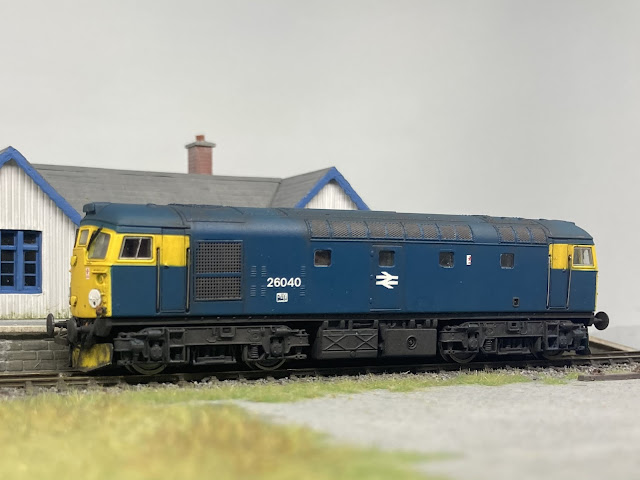McRat makeover (N part 63)…
Today our ‘ready to run’ models are often dressed in painstakingly researched and carefully checked clothes - to the extent there is little point in repainting if your chosen livery is available out of the box…
 |
| Top, rail turquoise gently weathered, bottom rail blue, gently weathered. |
Sadly, whilst many of Dapol’s N gauge models are nicely proportioned representations of their prototypes (the 22, 26/27/33 and 121/122 in particular) the shade they use on their rail blue often seems a long way from how we all remember it, you could joke it’s rail turquoise! I have lived with this for as long as I can, the model is so lovely I overlooked the colour and would adjust photographs I took to either be black-and-white or certainly reduce saturation. The time had come to do something more drastic!
 |
| The Dapol model with a little weathering. All these photos are taken under the same consistent layout lighting, to allow direct comparison. |
The only problem in this case was the fact I had already detailed and weathered the model. I wondered if it would be possible to preserve as much of this as I could, be careful masking. Carefully removing the body from the chassis, removing the cab side handrails and body side glazing, I figured I’d be able to mask the yellow ends without further dismantling. However, since I was repainting, I wanted to address one detail discrepancy on the Dapol body. They have represented a seal on the side windows Which the unrefurbished example certainly didn’t have, and not all of the refurbished ones received this modification. Careful work with a craft knife removed these without damage to the rest of the finish.
I use Humbrol masking tape to protect the yellow ends and around the cabside windows. Precision ‘rail blue’ Was sprayed using an airbrush. I used a gloss lacquer where I needed to add the Fox N gauge decals which are specifically for the Scottish locomotives as they feature larger body side numbers. At this point, I masked the glazing individually before applying a satin lacquer across the whole body, tying the two paint finishes together.
At this stage I was a little disappointed, the rail blue almost seemed to vibrant and without relief. I used a dirty black to pick out the roof cantrail grills (as above) and later the same shade on the body side grilles. This helped, and encouraged I moved onto weathering. My usual mix of Humbrol 98 and 33 were applied wet on wet to the roof and relief on the side. A wide flat brush moistened with thinners was used to remove much of this leaving a work stained finish (as below).
Seeing the character of this distinctive Scottish locomotive emerge a second time was a great relief. The weathering really bringing out that personality we are all so familiar with from period photography (or maybe if you are lucky first hand experience). Whilst I share these photos with you today, there is just one stage of the finish I have not completed, adding the exhaust deposits to the centre of the roof.
This project has only fanned the flame of my longing to create a larger N scale scenic layout, certainly with a Scottish flavour. Between times I have been busying myself in research again, enjoying photographs on printed page, the smell of an old book, the muscle memory in flicking pages, pausing on one favourite photograph and imagining being part of the scene before my eyes. In recent times I have settled upon the summer of 1984, to allow mixing 26s and 37/0 in blue and large logo, even an excuse to run oddballs like a class 27.
Sadly that means my 37/4 is now for sale, I’ll do a proper post another time but if you read this and are interested in the cover star of my second book, drop me an email. The price is £195 including UK delivery, but I will consider serious offers.
When I started work in British N gauge I saw it as an excuse to play trains with out of the box, lightly modified and weathered stock in the colourful liveries I remembered from childhood. As things have evolved I’ve now taken to kit builds and full repaints. I don’t think that is necessarily a bad thing, if anything it is a commitment and comfort with the scale. If you’ve not got space for the OO gauge layout you desire, or OO gauge feels too much of a scale compromise do consider N. Yes, it’s still narrower than scale but visually feels a good balance, especially when using the track from British Finescale. Until next time, more soon…
Donate
I love writing and creating material for the blog. If you enjoy what you read and engage with I would be appreciative of any donation, large or small, to help me keep it advert and restriction free.




Comments
Post a Comment
Thank you for leaving a comment on my blog - I appreciate you taking the time to share your views. If you struggle to log in, please turn off the ‘block cross-site tracking’ setting in your browser.
James.